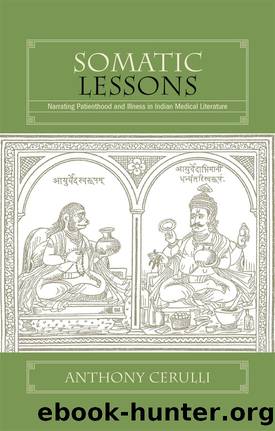Somatic Lessons: Narrating Patienthood and Illness in Indian Medical Literature by Anthony Cerulli

Author:Anthony Cerulli [Cerulli, Anthony]
Language: eng
Format: epub
Tags: Religion, Hinduism, General, Medical, Alternative & Complementary Medicine, ethics, history
ISBN: 9781438443874
Google: gqwJwT-yXNoC
Publisher: SUNY Press
Published: 2012-11-01T23:57:15.842263+00:00
Unlike the Carakasaá¹hitÄ, however, the KÄÅyapasaá¹hitÄ does not present us with similarly clear indicators that women were in any way involved in the adaptation of the RevatÄ«âJÄtahÄriá¹Ä« narrative to the medical context.
The lines of a gendered hierarchy are not blurred in this medical narrative, as Selby found them to be in the birthing accounts in the Carakasaá¹hitÄ. In fact, the very use of the RevatÄ«âJÄtahÄriá¹Ä« story demonstrates an attempt by the compilers of the KÄÅyapasaá¹hitÄ to buttress the male way of knowing over against the female way of knowing on the matter of embryonic ruin, miscarriage, and its socioreligious associations. In the RevatÄ«âJÄtahÄriá¹Ä« story, the entirety of the woman, her body and being in the world, becomes a vessel in which to produce and gestate an embryo, and eventually give birth to a baby. The woman literally becomes the womb. She is totally organic, a breathing machine, in the sense that her uterus subtends her whole nature. As a machine, when she acts, she runs the risk of breaking down. Machines are also manipulable. The presentation of miscarriage in KaÅyapa's compendium, in the RevatÄ«-JÄtahÄriá¹Ä« story itself and the subsequent elaboration of what a âjÄtahÄriá¹Ä«â is and does, serves up somatic lessons in this specific medical context that exploit this perceived manipulability.
Using the RevatÄ«âJÄtahÄriá¹Ä« story, the KÄÅyapasaá¹hitÄ's compilers effectively wrest control of women and human development from conception through gestation by co-opting women's power to define their somatic experiences for themselves. The story not only rewrites the female patient's somatic experience of miscarriage, but it also recounts that experience as an episode in a larger morality play about good and evil. This morality play is but a part of the grand narrative of âsupport for the youngâ (kaumÄrabhá¹tya) in the entire work, which itself is an arm of the knowledge for long life (Äyurveda) that defines the contours of classical Indian medicine. All of this knowledge surely does not come in the form of narrative discourse only. Where medical stories about the body serve as the platforms from which to impart medical knowledge, the ayurvedic compilers could secure the active consent of their patients to adopt not just their medical injunctions, but also the cultural values couched in their narratives. The adaptation of moral knowledge to the medical system in stories about the body facilitates a reformulation of common understandings of health and illness usually disseminated through standard chart talk, so that patients might begin to reexamine their illnesses along the normative lines of the narratives.
Download
This site does not store any files on its server. We only index and link to content provided by other sites. Please contact the content providers to delete copyright contents if any and email us, we'll remove relevant links or contents immediately.
Spare by Prince Harry The Duke of Sussex(5132)
Machine Learning at Scale with H2O by Gregory Keys | David Whiting(4256)
Fairy Tale by Stephen King(3305)
Will by Will Smith(2871)
Hooked: A Dark, Contemporary Romance (Never After Series) by Emily McIntire(2527)
The Bullet Journal Method by Ryder Carroll(2524)
Rationality by Steven Pinker(2325)
Can't Hurt Me: Master Your Mind and Defy the Odds - Clean Edition by David Goggins(2267)
It Starts With Us (It Ends with Us #2) by Colleen Hoover(2251)
Friends, Lovers, and the Big Terrible Thing by Matthew Perry(2177)
The Becoming by Nora Roberts(2147)
Love on the Brain by Ali Hazelwood(2019)
HBR's 10 Must Reads 2022 by Harvard Business Review(1820)
The Strength In Our Scars by Bianca Sparacino(1817)
A Short History of War by Jeremy Black(1815)
Leviathan Falls (The Expanse Book 9) by James S. A. Corey(1693)
A Game of Thrones (The Illustrated Edition) by George R. R. Martin(1657)
515945210 by Unknown(1640)
Bewilderment by Richard Powers(1574)
